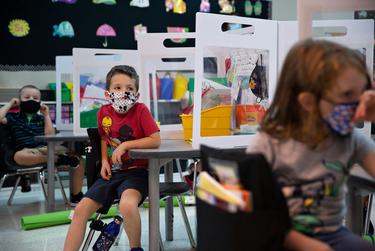Last Updated on May 10, 2021 – 10:15 PM CDT
This article originally appeared in The Texas Tribune: Read More
Declan True listens to his kindergarten teacher, Mrs. Hogan, on the first day of in-person classes at Highland Village Elementary in Highland Village.
Credit: Shelby Tauber for The Texas Tribune
Sign up for The Brief, our daily newsletter that keeps readers up to speed on the most essential Texas news.
When Texas schools returned to in-person education last fall, the spread of coronavirus “gradually but substantially accelerated,” leading to at least 43,000 additional cases and 800 additional deaths statewide, according to a study released Monday.
The study was done by University of Kentucky researchers for the non-partisan National Bureau of Economic Research in Cambridge, Mass., and tracked weekly average COVID-19 cases in the eight weeks before and eight weeks after the state’s school districts sent students back to school in the fall of 2020.
The researchers said the additional cases they tracked after students began returning to schools represented 12% of the state’s total cases during the eight weeks after reopening and 17% of deaths.
They analyzed three things: school district reopening plans in every county, COVID-19 cases and deaths, and cell phone data that showed how adult movement changed once a community’s children went back to in-person learning.
Researchers chose Texas because, by the fall term, most schools around the country were still closed as Texas and a handful of other states were reopening in “less-than-ideal circumstances,” said Aaron Yelowitz, an economics professor at the University of Kentucky and one of the study’s researchers. The state also provided good conditions for pre-vaccine study, he added, since data was collected from May 2020 until January, when vaccine rollout was still slow.
Though more adult Texans have since been vaccinated — about 30% have been fully vaccinated as of May 8 — Yelowitz said there are still communities in which their findings could matter moving forward, like areas with more vaccine hesitant or resistant people.
Across the state and rest of the country, school reopening plans divided many communities last year. Proponents of reopening schools said in-person schooling would improve learning, increase social interaction and allow access to state services like special education and free and reduced-lunch programs. Opponents said remote learning was safer and did not risk the lives of teachers, faculty and staff, particularly following an intense summer surge.
Last July, state leaders, including Abbott, gave individual school districts authority to make reopening decisions, even when they went against public health authority recommendations. The Texas Education Agency required districts to make on-campus attendance an option, stating that districts also had to let students study remotely.
When Abbott ended Texas’ mask mandate in March, he said public schools should operate under TEA’s eventual guidance. At the end of March, TEA released guidelines requiring face masks in school buildings, with some exceptions, including for students younger than 10 or while eating or exercising.
TEA did not immediately respond to requests for comment.
More than 60% of school districts opened schools at or near their typical date for the fall 2020 term, despite the state’s summer surge of cases, hospitalizations and deaths, according to the NBER report. The researchers estimated that more than 90% of Texas school districts opened at near capacity, without any staggered attendance plans, compared to more than 40% nationally.
Though otherwise healthy children are generally less likely to contract and transmit COVID-19, adults can still contract the virus from their students and co-workers at school. The study’s results could be explained by both direct school spread and the movement of adults returning to work and school, the researchers wrote.
“Reopening schools in a world where there wasn’t a vaccine at the time did cost lives, did cause infections, though probably did have some positive effects for the kids who were able to attend in person, rather than virtually,” Yelowitz told the Tribune.
Texas State Teachers Association President Ovidia Molina said she is worried about upcoming summer classes and another fall return. Last fall, she said, teachers reported inconsistent mask usage and expired cleaning supplies.
TSTA continues to push for requiring everyone to wear a mask in schools because it’s still hard to know who is vaccinated, she said.
Though in-person learning is valuable for students because of its learning and relationship benefits, Molina said many educators and staff have died of COVID-19, and the trauma that losing a teacher brings their students and coworkers is important to consider.
“It’s just this sense of urgency that we know we have and we feel, and we want others to have as well,” Molina said.
Disclosure: The Texas State Teachers Association has been a financial supporter of The Texas Tribune, a nonprofit, nonpartisan news organization that is funded in part by donations from members, foundations and corporate sponsors. Financial supporters play no role in the Tribune’s journalism. Find a complete list of them here.
